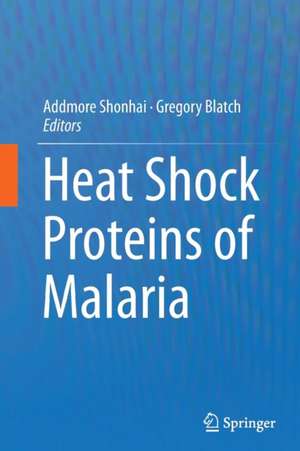Heat Shock Proteins of Malaria
Editat de Addmore Shonhai, Gregory L. Blatchen Limba Engleză Paperback – 23 aug 2016
Preț: 1027.69 lei
Preț vechi: 1081.77 lei
-5% Nou
Puncte Express: 1542
Preț estimativ în valută:
196.67€ • 204.57$ • 162.36£
196.67€ • 204.57$ • 162.36£
Carte tipărită la comandă
Livrare economică 12-26 aprilie
Preluare comenzi: 021 569.72.76
Specificații
ISBN-13: 9789402402599
ISBN-10: 9402402594
Pagini: 232
Ilustrații: VIII, 223 p. 35 illus., 33 illus. in color.
Dimensiuni: 155 x 235 x 12 mm
Greutate: 0.33 kg
Ediția:Softcover reprint of the original 1st ed. 2014
Editura: SPRINGER NETHERLANDS
Colecția Springer
Locul publicării:Dordrecht, Netherlands
ISBN-10: 9402402594
Pagini: 232
Ilustrații: VIII, 223 p. 35 illus., 33 illus. in color.
Dimensiuni: 155 x 235 x 12 mm
Greutate: 0.33 kg
Ediția:Softcover reprint of the original 1st ed. 2014
Editura: SPRINGER NETHERLANDS
Colecția Springer
Locul publicării:Dordrecht, Netherlands
Cuprins
Introduction: The importance of molecular chaperones in survival and pathogenesis of the malaria parasite Plasmodium falciparum.- General structural and functional features of molecular chaperones.- The role of Hsp70s in the development and pathogenicity of Plasmodium species.- Role of the Hsp40 family of proteins in the survival and pathogenesis of the malaria parasite.- Role of Hsp90 in Plasmodium falciparum malaria.- The role of parasite heat shock proteins in protein trafficking and host cell remodeling.- Role of heat shock proteins in immune modulation in malaria.- Establishment of Plasmodium falciparum extracellular compartments in its host erythrocyte.- Chaperones and Proteases of Plasmodium falciparum.- Heat shock proteins as targets for novel anti-malarial drugs.- What do we know, what do we not know, and what should the future focus be?.
Textul de pe ultima copertă
This book describes the role of heat shock proteins in the life cycle of malaria parasites. The work includes a general introduction on the structural and functional features of heat shock proteins. The main focus is on the role of heat shock protein families from Plasmodium falciparum, their role in protein folding and in the development of malaria pathology. The functions of individual families of heat shock proteins from plasmodium species and their cooperation in functional networks is described. Subcellular and extracellular organelles such as the apicoplast and the Maurer’s Clefts which are associated with plasmodium species, are discussed in detail. The role of heat shock proteins in the development and function of these organelles structures are highlighted. Although conceding that heat shock proteins may not be ideal antimalarial drug targets, prospects of targeting heat shock proteins in antimalarial drug discovery either directly and/or in combination therapies are explored.
Caracteristici
This is a novel area of malaria research that is very topical All of the chapters are written by leaders or experts in the field The chapters on drug discovery will appeal to the biotechnology industry Includes supplementary material: sn.pub/extras
